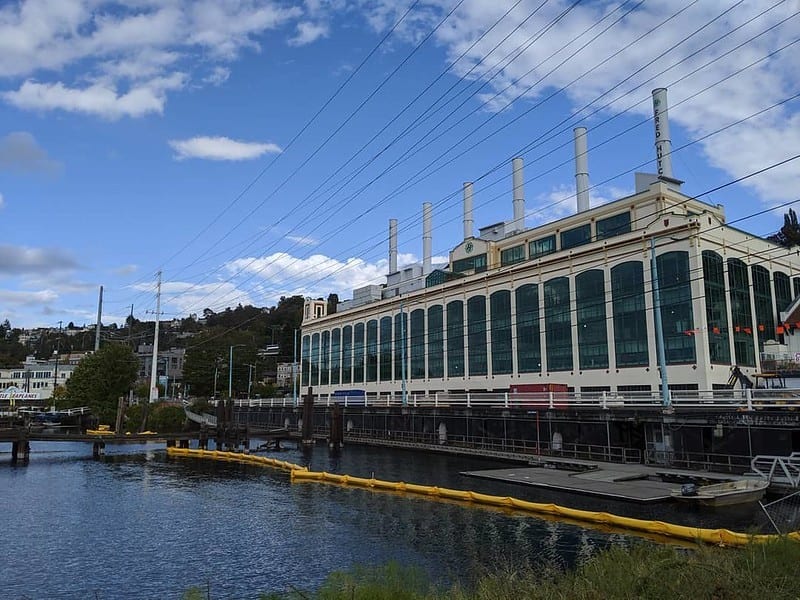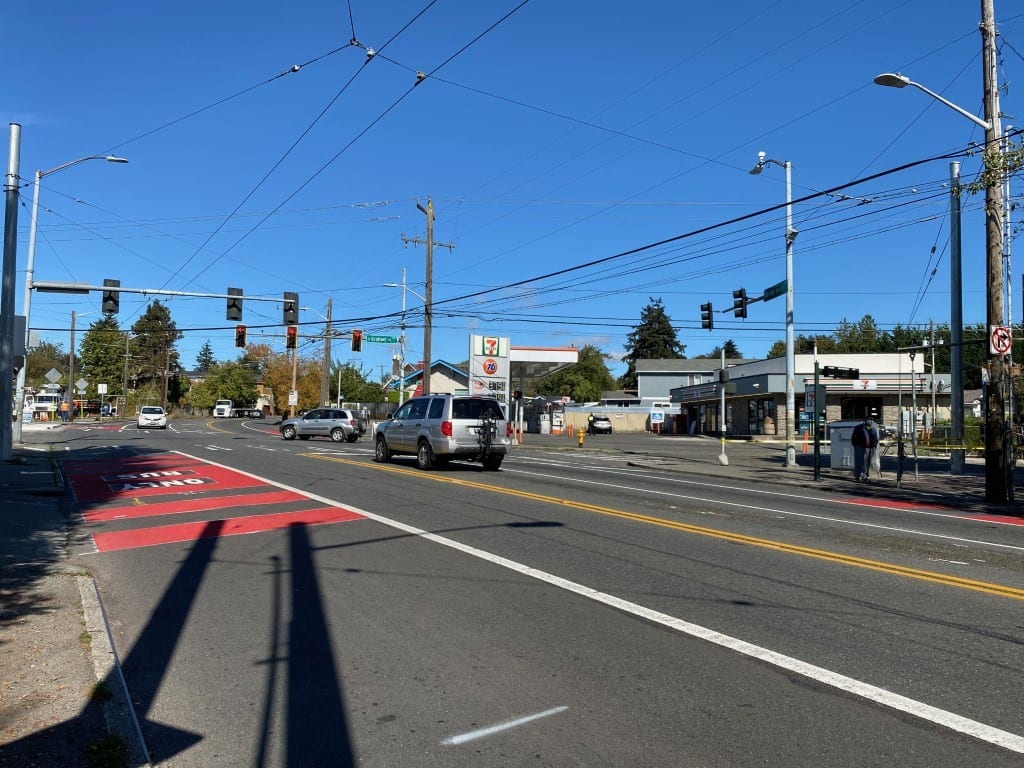 4th Ave bike lane, funded in part by the Levy. Photo Credit: Dongho Chang.
4th Ave bike lane, funded in part by the Levy. Photo Credit: Dongho Chang. Summary
- In July, August, and September (Quarter 3 or Q3) of this year – despite the many ongoing challenges facing our community – crews have continued to deliver on projects funded by the Levy to Move Seattle throughout the city that enhance safety, mobility, and livability for everyone.
- Today, we’re highlighting some of the most meaningful work that’s been completed in the third quarter of 2020, also covered in our Q3 report.
- Crews have been hard at work on the 4th Ave Mobility Project, bridge improvements, the NE Pacific St Paving Project, Rainier Ave S Vision Zero work, and much more.
- In response to new fiscal realities as a result of the pandemic, we are working on a 2020 COVID-19 Impact Assessment of the Levy to determine how remaining funding will be prioritized for Levy projects.
- We look forward to sharing the 2020 COVID-19 Impact Assessment of the Levy with you later this year.
In July, August, and September (Q3) of this year – despite the many ongoing challenges facing our community – crews have continued to deliver on projects funded by the Levy to Move Seattle throughout the city that enhance safety, mobility, and livability for everyone.
We discussed important Levy to Move Seattle milestones in the spring, and reviewed some of the historic challenges we faced to deliver projects we planned pre-pandemic and pre-West Seattle High-Rise Bridge closure. In the midst of these challenges, which have largely remained, we continued to deliver on Levy commitments. The successes can be seen across town, but we’re also working behind the scenes to prepare for big projects down the line.
It’s more important than ever that we make every penny count, and we want you to know that your tax dollars are hard at work. Today, we’re highlighting some of the most meaningful work that’s been completed in the third quarter of 2020.
It’s hard to talk about our Levy successes in 2020 without acknowledging the additional challenges and new bodies of work the brave people who make up our front-line crews have had to overcome and take on. This is in addition to their and everyone at SDOT’s commitment to build a more connected, livable Seattle by advancing and completing Levy-funded projects.

Crews hard at work on SW Avalon Way. 
Crews working along 4th Ave.
Our crews have played an invaluable role in the City’s COVID-19 response. Throughout 2020, SDOT crews have established and maintained over 20 miles of Stay Healthy Streets, created new curbside pickup locations across town to help our vital small businesses stay open, installed COVID-19 testing site traffic control and signage, created zones for essential workers outside of our major hospitals and health care centers, and so much more.
SDOT crews have been on the front lines responding to the West Seattle High-Rise Bridge closure – including bridge inspections, traffic mitigation, paving, detour signage, installing safer walkways and bike lanes.
This has all been while crew capacity was reduced due to COVID-19 and supplemental support curtailed as a result of our economic contraction and corresponding revenue shortfalls. Still, crews have continued working towards our shared Levy goals.
4th Ave Mobility Project

With the Levy, we’re investing in all kinds of transportation options – including the 4th Ave Mobility Project – to get people of all ages and abilities where they need to go. The new protected bike lane along 4th Ave expands the Center City Bike Network, a priority identified in the Seattle Bicycle Master Plan (BMP). The BMP is funded in large part by the Levy, and we work with the Seattle Bicycle Advisory Board to prioritize and make the best investments and maximize safety, connectivity, equity, ridership, and livability.
Late last month, thanks to the Levy, we built the first phase of the 4th Ave protected bike lane between Madison St and Pine St. As early as mid-November, we’ll extend the protected bike lane one way northbound another 5 blocks to Bell St Park. Next year, we plan to make the protected bike lane 2-way (within the same footprint) and extend it to Vine St. Projects like these make biking a more viable transportation option to and from downtown, and support environmental sustainability.
Investing in our Bridges

Earlier this year, we discussed our bridge maintenance program and commitments moving forward. At the same time, Seattle voters have repeatedly chosen to invest in transportation infrastructure and public safety. The Levy has funded critical improvements and additions to our city’s bridges, including some notable Q3 achievements below!
Cowen Park Bridge Seismic Retrofit
Earthquakes could have a significant detrimental effect on Seattle’s infrastructure. To address these risks, we established a bridge seismic retrofit program to assess the seismic vulnerability of our bridges and to prioritize limited funding to make them more resilient. As part of the Levy, the Cowen Park Bridge – built in 1936 and connecting the Roosevelt/Ravenna neighborhood with the University District – was among 16 bridges selected for seismic retrofits to help the bridge better withstand events like earthquakes.
Earlier this year, we completed work on the Cowen Park Bridge seismic retrofit! Improvements include: carbon fiber wrapping to strengthen the bridge’s crossbeams, columns, and arches; strengthening the existing arch with concrete infill; installing concrete blocks and supportive shells for the bride’s column’s and crossbeams; repairing cracks and concrete damages; and replacing the expansion joints at both ends of the bridge.
Other bridge achievements include:

- The Lander Street Overpass approached the finish line after 2 years of construction, and then opened to traffic in early October.
- We made visible progress on the Northgate Pedestrian/Bike Bridge which people will be able to walk and bike across by approximately Fall 2021.
- The W Howe St Bridge in Magnolia, built in 1946 and also selected for seismic retrofits, will also be strengthened to better withstand seismic events like earthquakes. Construction is expected to be complete this winter.
- We are completely rebuilding the Fairview Ave N Bridge, the last wooden bridge on a major road in Seattle. While safe for travel today, the bridge doesn’t meet current seismic standards. The new sidewalks, a bike lane, and slightly wider northbound vehicle lanes will make it safer for people to drive, walk, roll, bike, and access transit along Fairview Ave N.
NE Pacific St Paving Project
Every year, we pave streets to keep you moving, whether you’re biking, walking, riding the bus, or driving. Approximately 80% of the funding for these paving projects comes from the Levy. In other words, without the Levy, it would be extremely difficult for the City to keep our roads safe and healthy for all travelers. More often than not, when you see or feel fresh pavement under your feet or wheels, you have the Levy – and your tax dollars – to thank!
We repaved a stretch of NE Pacific St in front of the University of Washington Medical Center near Husky Stadium and the Montlake Bridge, which makes it safer and more comfortable to travel on while extending its useful life. Back in the spring, we had paused this project to ensure easy access to the UW Medical Center as the region responded to COVID-19. After communicating with the UW Medical Center, we were able to closely coordinate our road safety efforts with their public health obligations and resumed work in June to complete the repaving and safety improvements in August.
Rainier Ave S Vision Zero Improvements
Rainier Ave S is a busy street with restaurants, retail, salons, community centers, libraries, schools, and some of the highest levels of bus ridership in Seattle. Unfortunately, Rainier Ave S also leads the city in vehicle crashes. We can and we must do better, and the Levy has funded the completion of key safety projects along Rainier Ave S over the past few months.
The Rainier Ave S efforts are a part of our Vision Zero program to reach zero traffic fatalities or serious injuries by 2030, and our Safe Routes to School program to make it easier and safer for kids to walk or bike to school. This year, we completed the new street layout from S Kenny St to S Henderson St, which typically includes a parking lane, one driving lane in each direction, a center turn lane, and bus lanes. Reducing the number of travel lanes has been proven to reduce speeding – a key factor in the frequency and severity of crashes.
As part of our Safe Routes to School program, we’re making the intersection of Rainier Ave S and S Rose St safer for everyone. We have also adjusted signals at Rainier Ave S and S Holly St, and later this year will add a community crosswalk at this intersection.
Other highlights from Q3 include:
- We made construction progress on the Delridge RapidRide H Line.
- We passed Federal readiness requirements for the Madison Bus Rapid Transit/RapidRide G Line project, an important last step before receiving a Federal Small Starts grant that will cover about 45% of total project funding and allow us to begin construction on this important project in the heart of the city.
In response to new fiscal realities as a result of the pandemic, we are working on a 2020 COVID-19 Impact Assessment of the Levy to determine how remaining funding will be prioritized for Levy projects.
This assessment has been underway since June and we are bringing a draft to the Levy Oversight Committee in December, when they will meet with members of the Transportation Equity Workgroup to review and provide input on our findings and recommendations.
Afterwards, we will take the findings from this assessment process and develop a Levy Portfolio Status Update in Q2 2021 to outline what the levy will work to deliver through 2024 with the funding available. To learn more or ask questions, please email MoveSeattle@seattle.gov.
We work to make every tax dollar count, which includes partnering with other agencies, competing for grants, and leveraging Levy funds to make them go further.
Despite best efforts, many programs will not meet the entirety of the 2020 planned accomplishments. Approximately one-third of Levy programs have or will feel the effects of pressures on our crews. Simultaneously, the economic downturn brought on by COVID-19 has affected local funding sources that we leverage along with property tax to deliver the full Levy portfolio, including Vehicle License Fees, Real Estate Excise Tax, and grant funds. Fortunately, property tax revenues are not expected to notably decline.
Due to local revenue impacts, we needed to initially reduce the 2020 Levy portfolio budget by $23M. We have done this by pausing a small number of projects in 2020. These are just a small set of the many projects in the Levy portfolio, most of which we’ll continue. As we understand more about our expected future revenue, we will explore potential new funding sources to minimize impacts to Levy projects. For more information, view details on the 2021 proposed budget.
While Q3 2020 spending compares well against prior years, spending represents 75% of the spend plan, year to date. This is a direct reflection of our June decision to take thoughtful but immediate action to pause projects for the remainder of 2020—a decision in response to revenue impacts that reduced our overall funding —and limited crew capacity related to the Continuity of Operations Plan (COOP) and other COVID-19 response actions .
Through this work, we are guided by a commitment to:
Minimize direct impacts to vulnerable and underserved communities.
Engage in an equity-centered recovery process.
Maximize Federal and State funding opportunities.
Maintain funding and flexibility within larger transportation and mobility focused programs.
Preserve staffing levels, to the largest extent possible.


